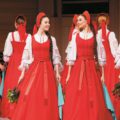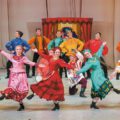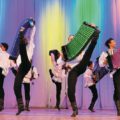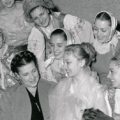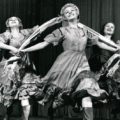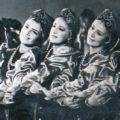A red sarafan, a twig of a birch tree, and a wave of a turquoise kerchief. All of these are the elements of maiden’s round dance, with which the Beryozka first performed in Hermitage Garden in 1948. The dance became not just a symbol of the ensemble. The great Russian choreographer Nadezhda Nadezhdina created a masterpiece that embodies all the beauty and the very essence of the Russian soul.
The ensemble
“One does not have to read 200 volumes about Russia; it’s enough to attend one Beryozka concert to understand the Russian spirit and character,” the French press reported after the Ensemble’s tour in Paris.
For over 70 years, the Beryozka has been sharing the Russian idea of beauty with the world. In 1948, Nadezhda Nadezhdina founded the State Academic Choreographic Ensemble and served as its artistic director and producer for many years. Since 2000, Beryozka has proudly borne the name of its founder.
Nadezhda Nadezhdina was a person of high culture and erudition, and she appreciated the richness of the art of the Russian people. As a talented scenarist, playwright and director, she managed to combine two core aspects of Russian culture: the traditional Russian folk maiden round dance and professional Russian ballet.
“Today, to make a person, who knows a lot and has seen much on the stage, love the dance of our ancestors, it should be performed not in the old Slavonic language, but in the modern Russian,” said Nadezhda Nadezhdina.
In her compositions, the dance becomes a majestic symbol. Nadezhdina’s masterpieces of Russian choreography (waltz “Beryozka”, “Lebedushka”, “Sudarushka”, “Balagury”, plays “Four Seasons” and “Yamshchiki”) were a breakthrough in the scenic embodiment of Russian dance. She was passionate about folk art and had a profound knowledge of Russian history, traditions, customs, and tales. She pursued her precious dream and dedicated her life to creating her own classical and folk stage performances.
Nadezhdina left a legacy of over 50 legendary plays. In 1959, as the male group joined the ensemble, its creative palette got new colors, and there appeared male and pair dances, such as “Topotukha”, “Uzory”, “Holiday Dancing”, “Karusel”, and triptych “Russian Porcelain”. However, the round dance has always been the basis of all Beryozka concert programs. The women’s round dance is the embodiment of supreme art and choreographic proficiency. And the seemingly simple so-called “Russian step”, later described as a floating one, still fascinates the audience with its flight above the ground.
Continuity
The poetic image of a Russian woman, praised by Nadezhda Nadezhdina, was vividly embodied in the personality of the ensemble’s lead soloist, Mira Koltsova who became its true symbol. Nadezhda Nadezhdina not only regarded her as a superb performer but also as her successor. In 1979, Mira Koltsova became the artistic director of the ensemble.
“We don’t dance for the sake of dance. Our performers must think, they must become intellectuals who can express maximum feelings with minimal gestures,” Mira Koltsova believes.
Her pieces of choreography, such as round dances “Raduga”, “Kolokoltsy”, “ Rechenka”, and dance “Razdolnaya” represent a worthy continuation of Nadezhda Nadezhdina’s legacy. Mira Koltsova succeeded in translating the ideas of the ensemble’s founder into reality as she turned a series of dances into a comprehensive show “Four Seasons”. Not only has she preserved this heritage, but also enriched it with new artistic images and added a modern perspective to it. The choreographic suite “Dedicated to Defenders of the Fatherland…” is a lyrical play with a heroic motif. Each figure in the large-scale folk dance mosaic “Petrushka” is colorful and has its own artistic characteristic. The play “Moscow Yard”, a signature ballet performance, is widely regarded as a breakthrough for the Beryozka.
Mira Koltsova has earned global acclaim as a performer and a ballet master, and her personal contribution to the development of contemporary Russian choreography is tremendous.
Orchestra
The Russian folk orchestra is an integral part of the Beryozka. After all, the audience enjoys the powerful musical background as much as the performances.
The orchestra’s repertoire was mostly created by composers Evgeny Kuznetsov and Victor Temnov. At different times, the orchestra was made up of accordionists and composers Alexei Ilyin, Vladimir Kornev, Gennady Lvov, Sergei Kolobkov, Mikhail Troitsky, and Yevgeny Derbenko, with Alexei Ilyin and Albert Ryzhkin as conductors. Since 1995, Leonid Smirnov, People’s Artist of Russia, has been the conductor of the orchestra, and Philipp Koltsov, Honored Artist of Russia, is the composer of the ensemble today.
The singing adds unique coloring to the orchestra’s music. It comes naturally with the dance and is quite simple. It does not sound like a professional chorus, but at the same time, it is harmonious and imbued with immediacy, just like the dance itself.
Costumes
The stage costume plays one of the most important roles in creating the choreographic image of the Beryozka. The mission of a costume designer is very complex, as it implies a myriad of creative and organizational tasks. Nadezhda Nadezhdina’s first designer and loyal companion was Lyubov Silich. Not only did she have a fine sense of the era, color, texture, and details, but she was also able to express the idea of the master and the content of the dance through her costumes. It was she who provided creative guidance to artists Grigory Belov and Tatiana Shamina. Since 1996, Tatiana has been continuing the traditions, translating ideas for new numbers into reality, as well as preserving and revamping the unique style of Nadezhda’s stage images.
Over two hours of roundelays and dances, the performers change costumes and headdresses more than 20 times. In total, the team has about 2000 costumes, which altogether weigh about 2.5 tons. Each one is a masterpiece made of velvet, chiffon, lace, batik, and embroidered with braid and beads.
Concert tours
The legendary Beryozka has been to almost every continent. The ensemble has traveled the length of the equator, mysteriously striding thousands of kilometers through stages of Japan, France, Argentina, Switzerland, Korea, and the US.
“The ensemble, together with the Bolshoi Ballet, became symbols of the USSR behind the Iron Curtain. We have traveled all around the globe and performed in over 80 countries! Heads of States and Governments attended our concerts almost everywhere we’ve been to,” says Mira Koltsova. It is no coincidence that back in 1959 the World Peace Council awarded the ensemble its Gold Medal.
The Beryozka had to perform under the most extreme conditions. For instance, they had to dance in felt boots and sheepskins when the temperature was 40°C in Greece. In 1973, they survived a coup d’état in Chile.
The ensemble carefully preserves its invaluable artistic and spiritual heritage. It is rightfully considered an extraordinary phenomenon in world culture as well as a true national treasure. Thanks to the talent and impeccable professionalism of the performers, the ensemble received the highest professional acclaim and captivated over millions of spectators in Russia and abroad. The concerts of the ensemble, which are distinguished by their rich repertoire and special spiritual atmosphere, always enjoy success.
Source and photos: beriozkadance.ru

